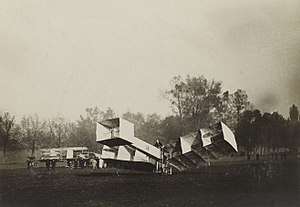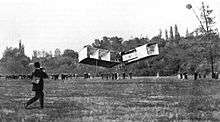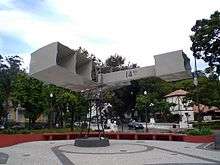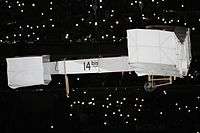Santos-Dumont 14-bis
The 14-bis (Quatorze-bis), also known as Oiseau de proie ("bird of prey" in French),[2] was a pioneer era canard biplane designed and built by Brazilian aviation pioneer Alberto Santos-Dumont. In 1906 near Paris the 14-bis made a manned powered flight that was the first to be publicly witnessed by a crowd.[3]
| 14-bis | |
|---|---|
 | |
| The 14-bis in its final form in November 1906, with octagonal-planform interplane ailerons | |
| Role | Experimental/Pioneer aircraft |
| Manufacturer | Alberto Santos-Dumont |
| Designer | Alberto Santos-Dumont |
| First flight | 23 October 1906 |
| Introduction | 22 July 1906 |
| Status | Destroyed in 14 April 1907[1] |
| Number built | 1 |
Background
In June 1905 Gabriel Voisin flew a glider which was towed by a fast boat on the River Seine, making a flight of over 150 m (500 ft). The glider's wing and tail were made up of Hargrave cells, a box kite-like structure that provided a degree of inherent stability. This established the Hargrave cell as a configuration useful not only for kites but also for heavier-than-air aircraft.[4] Santos-Dumont was living in Paris at the time, and was one of the most active "aeronauts" in Europe, having developed a series of non-rigid airships that displayed unparalleled agility, speed, endurance, and ease of control. Santos-Dumont met Voisin at the end of 1905, and commissioned him to help him construct an aircraft with the intention of attempting to win one of the prizes for heavier-than-air flights offered by the Aéro-Club de France to promote the development of heavier-than-air aviation in France.[5] These included the Coupe Ernest Archdeacon prize of a silver trophy and 1500 francs for the first flight of 25 m (82 ft) and another prize of 1500 francs for the first flight of 100 m (330 ft).[6]
Design
Santos-Dumont supervised construction of a Hargrave-cell (box kite-like) biplane powered by an Antoinette engine. The wings, each made up of three cells, were at the back and configured with pronounced dihedral to make the aircraft laterally stable. The 37 kW (50 hp) Antoinette liquid-cooled, fuel-injected V8 engine was mounted at the extreme rear end of the fuselage, itself located almost vertically equidistant between the biplane wing panels' wing roots, with the rear-mount engine driving a pusher propeller, and the pilot stood in a balloon basket immediately in front of the engine. A movable boxkite-style cell at the nose, pivoted on a universal joint within it and controlled by cables was intended for yaw and pitch control. This layout would later come to be called a "canard configuration". It was constructed from bamboo and pine joined by aluminium sockets and was covered with Japanese silk.[7]
Operational history

The first trials of the aircraft were made on 22 July 1906 at Santos-Dumont's grounds at Neuilly, where it had been assembled. In order to simulate flight conditions, Santos-Dumont attached the aircraft under his latest non-rigid airship, the Number 14, which is why the aircraft came to be known as the "14-bis".[8] The aircraft was then transported to the grounds of the Château de Bagatelle in the Bois de Boulogne, where there was more space. The forces imposed by the aircraft pulled dangerously at the airship's envelope, nearly tearing it and only allowing limited control. The danger of these tests caused Santos-Dumont and his team to quickly abandon them, although some useful information was obtained that led to adjustments in the balance and weight distribution of the aircraft.
Further trials were made with the aircraft hung from a rope attached to pulleys running along a 60 m (200 ft) long steel cable slung between two posts, one 13.5 m (44 ft) high and the other 7 m (23 ft) high,[9] much like a zip-line or tyrolienne of today.
The first free-flight trials of the 14-bis took place at the Polo Ground in the Bois de Boulogne on 21 August, but were halted by damage to the newly fitted aluminium-bladed propeller, which replaced one with silk-covered wooden blades.[10] After repairs another trial took place the following day; although the nosewheel left the ground, the aircraft had insufficient power to take off, and Santos-Dumont decided to replace the engine with a 37 kW (50 hp) Antoinette.[10] Trials resumed on 4 September without great success, and on 7 September, after the propeller was damaged, a new slightly larger one was fitted.[11]
On 13 September 1906 Aéro-Club de France observers gathered to witness an attempt to make a prize-winning flight. The aircraft failed to take off during a first attempt, but during the second it lifted and flew between 4 and 7 metres (13 and 23 ft) at an altitude of about 70 cm (28 in). The aircraft then landed in a nose-up attitude, breaking the propeller and bringing an end to the day's experiments. This brief flight did not qualify for any prize, but earned Santos-Dumont an ovation from the crowd.[10]
On 23 October, after a series of engine tests and high-speed ground runs (one of which ended as one wheel came loose, but this was quickly fixed), Santos-Dumont made a flight of over 50 m (160 ft) at an altitude of 3–5 m (9.8–16.4 ft).[12] This earned Santos-Dumont the first of the aviation prizes, 3,000 francs for a flight of 25 m (82 ft) or more.

This landing damaged the aircraft slightly, but Santos-Dumont announced that he should be ready to attempt the 100 meters prize on 12 November. The 14-bis was repaired, and octagonal ailerons were added to the middle of each outermost wing cell, with the surfaces pivoting between the outermost forward struts. These were operated by cables attached to the shoulders of the pilot's flightsuit, somewhat like the hip-movement wing-warping control of the Wright Flyer. On the morning of 12 November 1906 the aviation community of France assembled at the Chateau de Bagatelle's grounds to witness Santos Dumont's next attempt. As Santos-Dumont allowed the 14-bis to run down the field, a car drove alongside, from which Henry Farman dropped a plate each time he observed the wheels of the aircraft leave the ground or touch down again. The first attempt achieved a 5-second flight of about 40 m (130 ft) around 40 cm off the ground, and the second two brief flights of 40 and 50 m (160 ft). A hurried landing due to the proximity of some trees after this second attempt damaged the wheel axles, and these were fixed during a lunch break. In the afternoon, further flights of 50 meters and then 82 m (269 ft) (achieving about 40 km/h), this one interrupted by the proximity of a polo barrier. As the sun set, Santos-Dumont attempted one more flight. In order to ensure he would not hit the spectators, who by this time were all over the field, he pulled up while flying over them. After 22 seconds, he cut the engine and glided in to land. He had flown for 220 meters (over 700 ft), qualifying for the second aviation prize offered for heavier-than-air-aircraft, 1,000 francs for a flight of 100 meters or more. This was the last recorded flight of the aircraft.[13] The next notable Santos-Dumont flights were made in November 1907, flying his No. 19 Demoiselle.[14]
14-bis vs. Wright Flyer
Some contend that the 14-bis rather than Wright Flyer was the first true airplane.[15] For takeoff the 1903 Wright Flyer used a launch rail and a wheeled dolly which was left on the ground; the airplane landed on skids due to the sandy landing surface at Kitty Hawk.[16] After 1903 the Wrights used a catapult to assist most takeoffs of their 1904 and 1905 airplanes. The Santos-Dumont 14-bis did not use a catapult and ran on wheels located at the back of the aircraft, with a skid under the front of the fuselage.
The Fédération Aéronautique Internationale (F.A.I.) ("International Federation of Aeronautics"), founded in France in 1905 to "regulate the sport of flying" and to keep track of aviation records and other aeronautical activities, stated among its rules that an aircraft should be able to take off under its own power in order to qualify for a record. Many Brazilians therefore hold the 14-bis as the first airplane and Santos-Dumont is revered as Father of Aviation in the country. On October 5, 1905 Wilbur made a circling flight of 24 miles (38.9 km) in 39 minutes 23 seconds,[17] over Huffman Prairie near Dayton, Ohio, a year before Santos-Dumont's 50 metres (160 ft) flight earned him his first aviation award.
Written and photographic documentation by the Wrights authenticated by historians shows that the 1903 Wright Flyer accomplished takeoffs in a strong headwind without a catapult and made controlled and sustained flight nearly three years before Santos Dumont made his first takeoff.[18][19][20] Official records and motion picture footage show that the 14-bis achieved unaided takeoff on wheels.
Specifications
Data from www.aviafrance.com[21]
General characteristics
- Crew: 1
- Length: 9.6 m (31 ft 6 in)
- Wingspan: 11.46 m (37 ft 7 in)
- Wing chord:2.5 m (8 ft 2 in)
- Height: 3.75 m (12 ft 4 in)
- Wing area: 52 m2 (560 sq ft)
- Gross weight: 290 kg (639 lb)
- Powerplant: 1 × Antoinette 8V V-8 water-cooled piston engine, 37 kW (50 hp)
- Propellers: 2-bladed paddle blade pusher propeller
Performance
- Maximum speed: 40 km/h (25 mph, 22 kn)
- Range: 0.22 km (0.14 mi, 0.12 nmi) demonstrated
- Wing loading: 5.7 kg/m2 (1.2 lb/sq ft)
- Power/mass: 0.12 kW/kg (0.073 hp/lb)
Media

 14-bis on a French postcard
14-bis on a French postcard- Model of 14-bis, with octagonal ailerons
 14-bis Square in Petrópolis, Rio de Janeiro, Brazil
14-bis Square in Petrópolis, Rio de Janeiro, Brazil Replica 14-bis at the 2016 Summer Olympics opening ceremony
Replica 14-bis at the 2016 Summer Olympics opening ceremony
Legacy
The 14-bis was featured as one of the highlights of Brazil during the 2016 Summer Olympics opening ceremony.[22]
References
Notes
- "O 14-Bis ainda existe?". Archived from the original on February 21, 2019. Retrieved July 15, 2019.
- Bruce, Stuart E. Mechanical Flight Flight, 20 February 1909, p.108
- "10 Milestone Flights". Air and Space Magazine.
- Gibbs-Smith 1974, p.160
- Wykeham 1962, pp.202-3
- Gibbs-Smith 1974, p.137
- Gibbs-Smith 1974, p.212
- Le Aéroplane Santos-Dumont l'Aérophile, July 1906, p.167
- Le Aéroplane Santos-Dumont l'Aérophile, July 1906, pp.168–9
- L'Essor de Santos-Dumont l'Aérophile, September 1906, pp.191–4
- Gibbs-Smith 1874, p.218
- La Deuxième envolée de Santos-Dumont L'Aérophile October 1906, p.245
- Flight, 1909, p.12
- "l'Aéroplane Santos=Dumont No. 19". l'Aérophile (in French): 314. November 1907.
- "The Case for Santos-Dumont". wright-brothers.org. Retrieved 9 May 2014.
- Kelly, Fred C. (1989). The Wright brothers : a biography (Dover ed.). New York: Dover Publications. pp. 249. ISBN 9780486260563.
- Sharpe, Michael (2000). Biplanes, Triplanes and Seaplanes. Friedman/Fairfax. p. 311. ISBN 1-58663-300-7.
- "1903-The First Flight – Wright Brothers National Memorial (U.S. National Park Service)". National Park Service.
- Gibbs-Smith, C. H. (2002). The Wright Brothers : aviation pioneers and their work 1899–1911 (2. ed., repr. with new index. ed.). London: Science Museum. p. 44. ISBN 9781900747448.
- Gray, Carroll F. "The 1904 Huffman Prairie Experiments, The 1904 Flyer & The Search For A "Practical Machine"". WW1 AERO – The Journal of the Early Aeroplane (182): 5–21.
- "Santos-Dumont 14 bis, avion expérimental par Aviafrance".
- Rio 2016 Opening Ceremonies (5 August 2016)
Bibliography
- Gray, Carroll F. "The 1906 Santos-Dumont No. 14bis". World War I Aeroplanes, Issue #194, November 2006, pgs. 4–21.
- Gibbs-Smith, C. H. The Rebirth of European Aviation. London: HMSO, 1974 ISBN 0 11290180 8
- Joao Luiz Musa, Marcelo Breda Mourao, and Ricardo Tilkian, Eu Naveguei Pelo Ar ("I Flew Through the Air") 2003
- Alberto Santos Dumont A Conquista Do Ar ("The Conquer of the Air") 1901
- http://www.santosdumont.14bis.mil.br/
- http://www.thefirsttofly.hpg.ig.com.br/pioneer2.htm
- Hippolyto Da Costa, Fernando. Alberto Santos-Dumont: The Father of Aviation. transl: Soares, Hercillio A. VARIG Maintenance Base, Rio: 1973.
- Lins de Barros, Henrique. Alberto Santos-Dumont. Associacao Promotora Da Instrucao, Rio de Janeiro: 1986.
- Tobin, James. To Conquer the Air: The Wright Brothers and The Great Race for Flight. Free Press, New York: 2003.
- Wykeham, Peter. Santos Dumont: A Study in Obsession. London: Putnam, 1962
External links
| Wikimedia Commons has media related to Santos-Dumont 14-bis. |